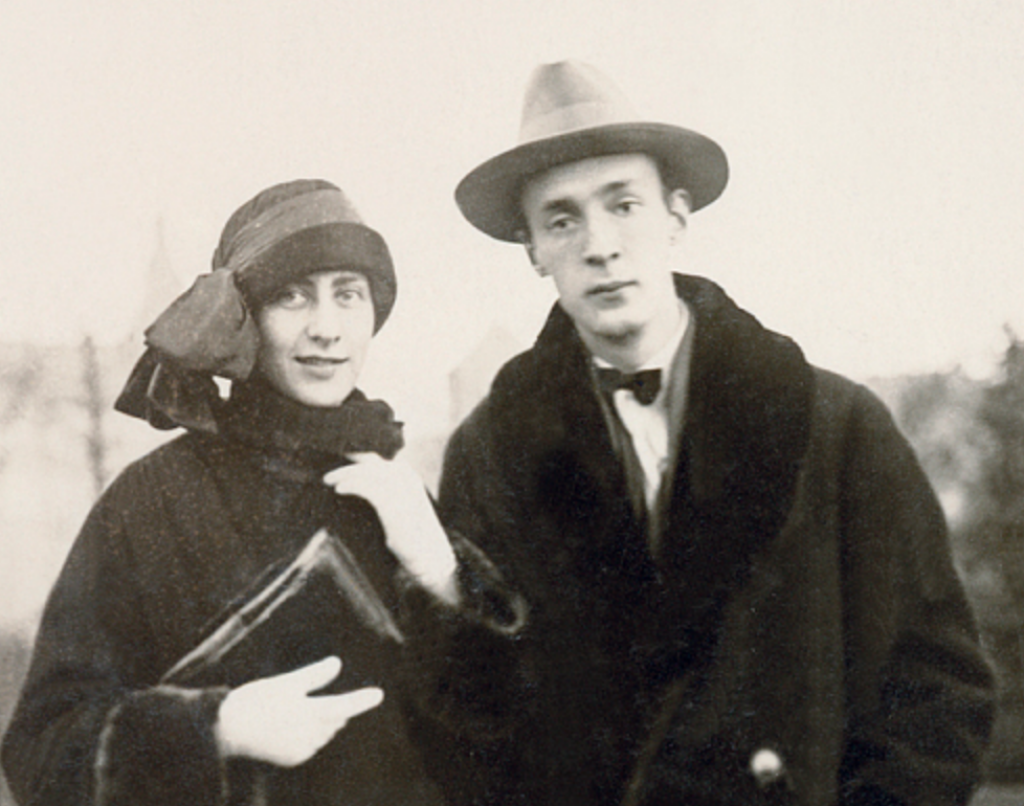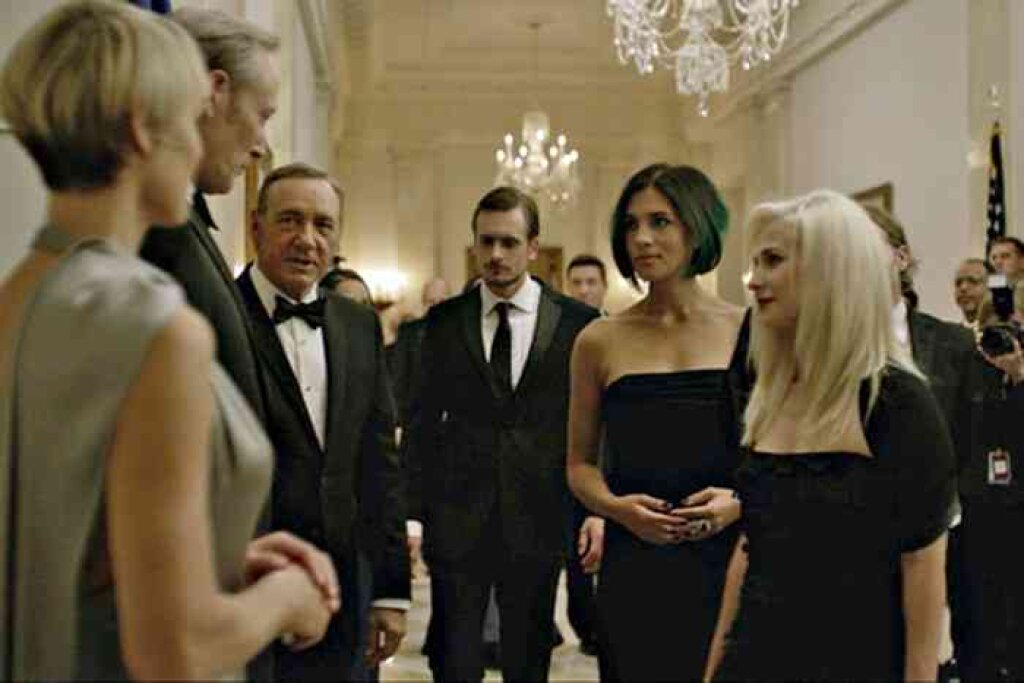Sara Karpukhin is a Lecturer in Russian at the University of Wisconsin-Madison. Her interests include queer and feminist theory, political uses of history and aesthetics, individual agency in art, and Vladimir Nabokov. She is a co-editor of Reimagining Nabokov: Pedagogies for the 21st Century (Amherst College Press, 2022).
A version of this post appeared in the Spring 2023 issue of The Slavic and East European Journal.
Above: Nabokov and Vera Slonim, his future wife, in Berlin in 1924.
One of the greatest literary artists of the twentieth century, Vladimir Nabokov was also a trained lepidopterist. Although the two great spheres of his interests have been studied extensively separately, there is an underexamined overlap between them that can be loosely be called a theory of literary evolution. My research traces the origins and development of this theory throughout Nabokov’s career and life, across genres and languages. The value of this theory lies not so much in its explanatory power in the context of today’s evolutionary literary criticism as in the glimpses it offers into the writer’s own unique experience: it is no less than an ingenious personal strategy of conceptual self-preservation. Especially striking is Nabokov’s contention that writers from different epochs see color, specifically the blue-red corner of the visible spectrum, “more distinctly” than their predecessors.
Nabokov first linked color description with literary history in a little-known 1927 lecture on Nikolai Gogol. inaugurating a lifetime of interest in the individual writer as an agent of evolutionary change. This emphasis on the individual would later recur in Nabokov’s writing on natural evolution, leading scholars to classify the writer’s views on evolution as a “modified Lamarckism.” In fact, the preference for spontaneous individual agency over impersonal causality contradicts Darwinian evolutionary theory and literary history alike, given that both areas of study make general claims about large, abstract groupings like species or literary movements. And yet, from the very start, Nabokov seemed less committed to rationalizable laws than to polemical assertions of the individual’s free creative power.
In that, he was not alone. The immediate audience for his Gogol lecture was the Berlin Literary Circle, which centered around the critic Iulii Aikhneval’d. Aikehnval’d’s work, like Nabokov’s, ardently defended the individual artist from the risk of erasure by impersonal historical forces. The émigré Russian-speaking community as a whole saw mitigating this risk as a matter of practical survival.
Besides Aikhenval’d, Nabokov found another ally in prominent critic and poet Vladislav Khodasevich. Khodasevich waged an ideological and philosophical war against the Soviets, taking aim at Marxism, with its impersonal determinism, as well as the Russian Formal School. Khodasevich saw Russian Formalism as part of the same reductive, deterministic force that threatened to discard the individual in the name of implacable, impersonal progress—but now specifically in the realm of literature.
It has been said that Khodasevich critiqued the Formalists, but adopted some of their tools. As for Nabokov, he fought the Formalists with their own weapons. The context of the polemic with Formalism, palpable in another Berlin Literary Circle lecture, “On Generalities” (1926), as well as in a passage in The Eye (1930) that parodied Karl Marx’s historical determinism, suggests that Nabokov first invoked the concept of literary evolution to mark himself as “more evolved” than exponents of Soviet Russian-language literature. Appropriating scientizing language of progress used in Marxism and Formalism, he used it to emphasize the irreducibility of the individual— himself—to the impersonal material forces these ideologies championed. In effect, he fought a practical, personal war of survival with the very theoretical weapons that threatened him in the hands of Marxist and Formalist critics.
Color perception played an important role in this process from the very beginning of Nabokov’s career, as in the 1927 Gogol lecture. But it was in his greatest Russian-language novel, The Gift (1938), that Nabokov used color to ground the concept of artistic talent in the irreducible individuality of perception. The novel’s protagonist, Fyodor Godunov-Cherdyntsev, connects the origins of his creative life with his own synesthesia—specifically, “colored hearing.”
The ensuing discussion of colors includes Lev Tolstoy’s sense of lilovyi, reddish blue or purple. The Russian Formalists, followed by the Russian émigré literary community, had earlier noticed Tolstoy’s tendency to use lilovyi to mark significant objects in his fictional worlds. Nabokov contributed to this conversation when, in a 1938 letter to an American graduate student, he linked color sensitivity to “the growth and maturity of literature” and added that “Ivan Bunin saw purple keenly as an extreme degree of density in the blueness of the sky and sea.”
Upon arriving in the United States in 1940, Nabokov found himself confronting a new set of deterministic narratives, this time those of American academia. He had to teach works of literature and engage in rationalizations that differed little from those with which the Russian Formalists indirectly threatened him as a “loser” of history: a Russian writer living outside the Soviet Union. American literary studies operated under the similar premise that individual artistic talent could be explained as an epiphenomenon of impersonal historical forces. Nabokov, with his fluid and hard-to-describe cultural affiliation, and his experience of surviving the effacing effects of historical processes, was once again on the defensive.
Besides famously dismissing various literary -isms and schools, he expanded his earlier statements on literary evolution and its connection to color. In his 1944 book on Gogol, he emphasized that it was the writer’s genius (a word he used 25 times in the book), rather than any knowable historical processes, that made possible the unprecedented, true-to-life descriptions of color in Gogol’s works. Similarly, Nabokov argued that it was genius that enabled the anonymous author of the twelfth-century Song of Igor’s Campaign to create the poem’s “blue wine” and “blue lightning.” So great was Nabokov’s wish to elevate therole of individual artistic perception in these texts that he gladly sacrificed the idea of progress. The Old Slavic poet was “ahead of his first editor’s time,” Nabokov claimed—that is, ahead of the normative aesthetics of the early nineteenth century—in describing the color so clearly. Even in a scholarly commentary, the Russian-American writer saw artistic individuality as transcending time and place, with the artist’s superior perceptual capacity constituting a miracle inexplicable in the rational language of literary historical studies.
In a testament to the personal stakes of Nabokov’s theorizing, a letter to Alfred Appel Jr. dating to the late 1960s explicitly includes the author himself in this color-based theory of literary evolution. In all instances, Nabokov acted as a creative writer struggling to leave maximum conceptual room for his own agency, purposefully moving against the grain of literary studies and the expectation of deterministic, rationalizing causality. In his American period, the writer wrestled with threats much like those he had confronted during his Russian period, when he had faced off against Marxist historical progressivism and the Russian Formalist conception of literary history as defined by impersonal processes.
Nabokov’s theory of literary evolution thus emerges as a striking example of individual conceptual adaptability. Writing in Russian in exile, on the margins of the European societies where he physically existed, his books banned in metropolitan Russia; and then writing in English as an immigrant in America, an outsider novelist within American academia, Nabokov resisted effacement when he insisted on grounding literary excellence in the inalienable cognitive specificity of an individual artist: color vision. The appropriation and inversion of the prestigious, dominant language of science afforded him an uncommon means of recovering from the trauma of exclusion, which that language had inflicted on him both at a historical-biographical and a conceptual level.



